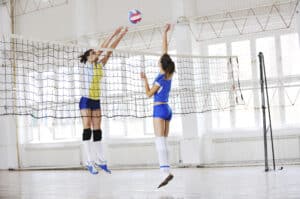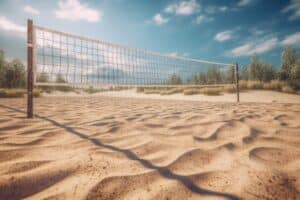What do you put around a sand volleyball court?
Key Takeaways
- Railroad ties are considered one of the best materials for sand volleyball court boundaries, providing durability and a clear boundary.
- Tape or rope can be used to create boundaries, offering flexibility, easy installation, and clear visual markers.
- Fencing and division netting are recommended as border options, establishing clear boundaries and preventing sand spillage.
A sand volleyball court is a popular recreational and competitive space for players to enjoy the game. When building or setting up a sand volleyball court, it is important to consider the materials used to create the boundaries and markers around the court. These boundaries not only define the playing area but also help in maintaining the sand within its designated space and prevent grass or other elements from encroaching onto the court.
The best materials for sand volleyball court boundaries largely depend on various factors such as durability, safety, visibility, and resistance to wear and tear. Different sources provide different recommendations for materials that can be used to create the boundaries of a sand volleyball court. Let’s explore the various options available:
Railroad Ties
According to Volleyball.com, railroad ties are considered one of the best materials for sand volleyball court boundaries. They are durable, provide a clear boundary, and help to contain the sand within the court. However, it is important to note that railroad ties can pose a safety hazard due to their hardness and potential for splintering. To mitigate this risk, some experts recommend padding the railroad ties with materials such as foam pipe insulation.
Tape or Rope
VolleyballUSA.com suggests using brightly colored tape or rope to create the boundaries of a sand volleyball court. These materials are flexible, easy to install, and can provide a clear visual boundary. It is recommended to use thick 2″ wide webbing for the boundary lines to ensure visibility and durability.
Fencing and Division Netting
USAVolleyball.org recommends using fencing and division netting as border options for a sand volleyball court. This helps to establish a clear boundary and prevents sand from spilling out of the court. Additionally, courtside banners can also be utilized to mark the boundaries and add a professional touch to the court.
FlexEdge Beach Volleyball Rubber Border
SportsEdge.com suggests using the FlexEdge Beach Volleyball Rubber Border as a recommended border option. This specialized rubber border is designed specifically for sand volleyball courts and helps to maintain the integrity of the court boundaries while providing a safe and visually appealing boundary.
It is important to note that the choice of materials for sand volleyball court boundaries depends on various factors such as personal preference, budget, and local regulations. Different materials may have different pros and cons, so it is essential to consider these factors when making a decision.
How to Properly Mark Off a Sand Volleyball Court
Creating accurate and visible markings on a sand volleyball court is crucial to ensure fair play and consistent gameplay. The dimensions and lines of a sand volleyball court should follow international regulations and standards. Here is a step-by-step guide on how to properly mark off a sand volleyball court:
- Measure the court dimensions: According to CourtsDimensions.com, the standard dimensions for a sand volleyball court are 8 meters by 16 meters for the playing area. It is important to measure and mark these dimensions accurately to ensure the court meets official standards.
- Boundary Lines: Mark the outer edges of the court with durable materials such as tape or paint. These lines establish the legal playing area and help to define the boundaries.
- Centerline: Similar to indoor courts, a centerline should be marked in the middle of the sand volleyball court. This line divides the court into two halves and helps in determining player positions during gameplay.
- Attack Lines: Mark the attack lines, also known as 3-meter lines, on each side of the court. These lines run parallel to the centerline and are used for serving and player positioning.
- Net and Antennae: Set up a net with the appropriate height for men’s and women’s beach volleyball. Place antennae, vertical rods, 80 centimeters above the net to evaluate if the ball crosses the net within their limitations.
It is important to ensure that the lines and markers are accurately measured, clearly visible, and won’t fade or wear out quickly. Using high-quality materials that can withstand the beach environment and constant use is essential for maintaining the integrity of the court markings.
Please note that the specific details for marking off a sand volleyball court may vary depending on local regulations and personal preferences. It is always recommended to consult the official regulations and guidelines provided by relevant sports organizations or local authorities.
Related Websites:
- Volleyball.com – Build a Volleyball Court
- CourtsDimensions.com – How to Build a Sand Volleyball Court
- VolleyPlan.com – Sand Volleyball Court Dimension, Surface, Lines, Maintenance
- VolleyballUSA.com – How to Build Your Own Sand Court
- USAVolleyball.org – How to Build a Beach Court
- SportsEdge.com – FlexEdge Beach Volleyball Rubber Border
FAQs:
Q: Why is safety important when setting up a sand volleyball court?
Safety is important when setting up a sand volleyball court to prevent injuries. Proper court setup and using a soft, impact-absorbing material around the court can help reduce the risk of players getting hurt.
Q: What is the purpose of boundary lines in a sand volleyball court?
Boundary lines in a sand volleyball court define its dimensions and help ensure fair play and accurate judgment. Clear and visible lines contribute to a better gameplay experience.
Q: What are the advantages of using tape or paint for boundary lines?
Using tape or paint for boundary lines offers durability and low maintenance requirements. They provide clear and long-lasting lines for competitive play.
Q: What are the options for barriers around a sand volleyball court?
Barriers around a sand volleyball court prevent sand from spreading and enhance aesthetics. Wood, plastic, and rubber edging are popular options for effective boundary barriers.
Q: How can sand quality be maintained in a sand volleyball court?
Using suitable sand is crucial for optimum gameplay. Regular maintenance such as raking and leveling helps maintain the quality and consistency of the sand.






